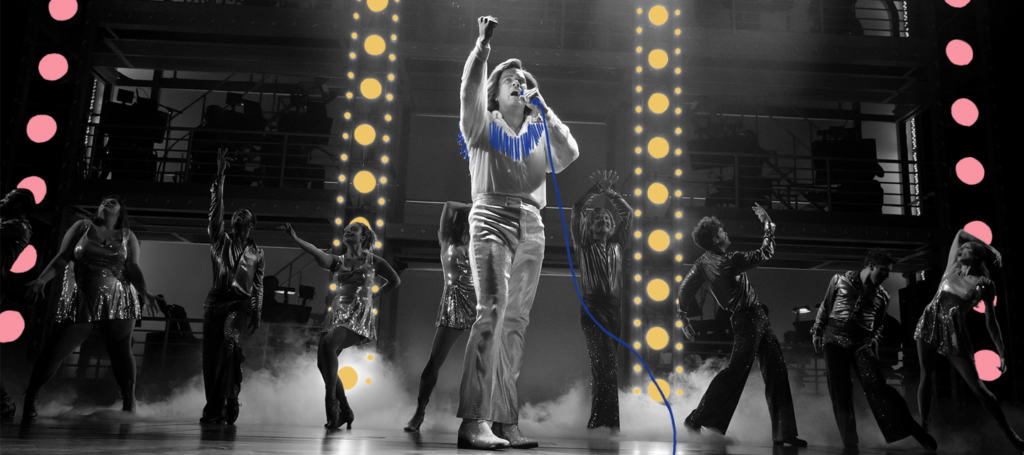


‘A Beautiful Noise’ Serves Cheap Thrills but No Drama
Using therapy as the framing for a musical play is a theatrical cheat. In such instances, rather than develop nuanced motivations or put effort into finessing a resolution, playwrights telegraph that their characters are working through trauma and are to be forgiven for anything they do or say―no matter how boring or formulaic.
And so it is in Anthony McCarten’s book for A Beautiful Noise, the new Broadway musical stage-bio of Neil Diamond’s life. In the present day, Diamond (Mark Jacoby) has been sent by his third wife Katie to see an unnamed Doctor (Linda Powell, a Black woman and the only lead character without an actual name). The plan is to work on his communication issues. But Diamond doesn’t want to.
After a few silent sessions, he is ready to give up. As a last resort, Doctor pulls out a book of his lyrics as a means of exploring where he was emotionally when he wrote them. She’s inspired to do so because he previously insisted that he put everything into his songs. From here, the show expands into a Vegas-style concert revue of the Diamond catalog―replete with Wikipedia-light narration enacted by an ensemble for his memories and his younger incarnation (Will Swenson).
Though the framing is cheap and obvious, director Michael Mayer uses it to make some entertaining choices. Such as blackouts and quick costume changes during the stalled therapy sessions to denote changes in time, or by having the ensemble of characters step forward from behind Diamond’s chair―possibly through a trapdoor or blackout curtain―to indicate that they are springing directly from his memories.
What is less successful is Steven Hoggett’s choreography, which gets stuck in a morass of So You Think You Can Dance-styled lyrical movement mashed with California-groovy affectations. Early in his life, Diamond self-describes himself as gloomy with a cloud over his head. Rather than follow the narrative development of his blossoming from a repressed bloke into an adoration-loving entertainer, Hogget’s movement scheme is effusively full-out from the start.
That is in keeping with McCarten’s “keep it light and substanceless” narrative. True to the stage-bio formula, rather than focus on a specific period in Diamond’s life, McCarten force-marches us through his early breakout until the dissolution of his second marriage in 1995―a span of 32 years. The only moments of tension in this litany of relentless triumphs are: his first divorce; caused by his affair with his eventual second wife, his struggle to write a hit album to escape a bad record label contract, and his divorce from his second wife.
Though these individual blips likely contained enough angst to launch an entire Netflix series, they are each dispatched within 15 minutes, sans deep investigation. As evidenced by reactions from the predominantly white and 60-to-70-year-old audience around me, perhaps such pandering is the key to Broadway success.
In the first act closing sequence, strains of Diamond’s hit “Sweet Caroline,” begin to waft beneath a discussion of his coming success. Soon, lights shine onto the audience as an indication that it is their turn to join in on the karaoke. At the performance I attended, once the chorus began, they seized that invitation with zeal.
Twenty years ago, the ABBA musical Mamma Mia! did the same thing. And though this musical is based on a “real story,” what worked in the early days of post-9/11 trauma works just as easily with A Beautiful Noise. Unlike those around me, I hated it.
And though the show successfully adheres to its formulaic logic, its paper-thin analysis of what makes Diamond gloomy―the supposed raison d’être for this affair―left me bored. Which begs the question, why not dispense with the drama and simply put on a tribute concert?
Performance-wise, Swenson is fine. As Diamond, he sheds the fervent intensity that he poured into his most notable performances―Berger in Hair, Mitzi in Priscilla Queen of the Desert, and Javert in Les Misérables. It is clear that he is taking this role seriously. I wish that the show would repay the investment.
Two dramatically satisfying moments indicate that it could have. While exploring Diamond’s lonely and imaginary friend-filled childhood, Jordan Dobson is brought onstage to sing a beautifully delicate and entirely contemporary interpretation of one of Diamond’s most personal songs, “Shilo.” Here, it is suggested that the stage ensemble, who have been recreating his memories, are his former imaginary friends―paving the way forward for a frightened boy to feel safe and still supporting him as he confronts his inner turmoil.
But even that tenderness is eclipsed by the revelation that current-day Diamond is grieving because he can no longer perform and now feels as if he has lost all purpose for being. In 2018, Diamond was forced into relative retirement by his struggles with Parkinson’s disease. Though his medical condition goes unmentioned here―another missed opportunity―watching Jacoby speak through tears and finally open up to sing alongside his younger self to declare that he is still here and is enough, reduced many people around me to tears. It was electrifying and entirely out of place in this amusement-park-scaled juggernaut.
And perhaps that is why the show will enjoy a long run. It knows its audience base and delivers the cheap thrills that they crave. To quote Diamond, “So good; So good; So good.” But never brilliant.
**Trigger warning: A word of caution. If you suffer from photosensitive epilepsy―as 1 in 100 adults do, compared to the 1 in 200 adults who have allergies to peanuts―there are many light effects in the second act that might trigger an episode. Though there is a note of thanks in the program from Diamond, about his appreciation for the show, there is no warning about these light effects. It is clear where the producers’ priorities are.
Keep Reading

If the Refreshing ‘KPOP’ is the Future of Broadway, Consider Me a Stan
Against all expectations for a behind-the-scenes musical drama, KPOP’s storytelling is as sophisticated as its high-octane performances. Though the newly-opened Broadway musical at Circle in the Square Theater was a hit during its pre-pandemic run at Ars Nova, I was prepared to hate-watch it. Why? Because I wince whenever I hear the cheesy bops of […]
Read More
In ‘A Christmas Carol,’ a Classic Tale Made to Feel Anew
“Marley is dead.” Everybody knows that. So it’s spoken, most assuredly, that first line of that familiar story. Starting with a match lit in the dark, a whole world starts to unravel around the sole performer who, with every small shift in his posture, and in the timbre of his voice, will embody almost every […]
Read More












